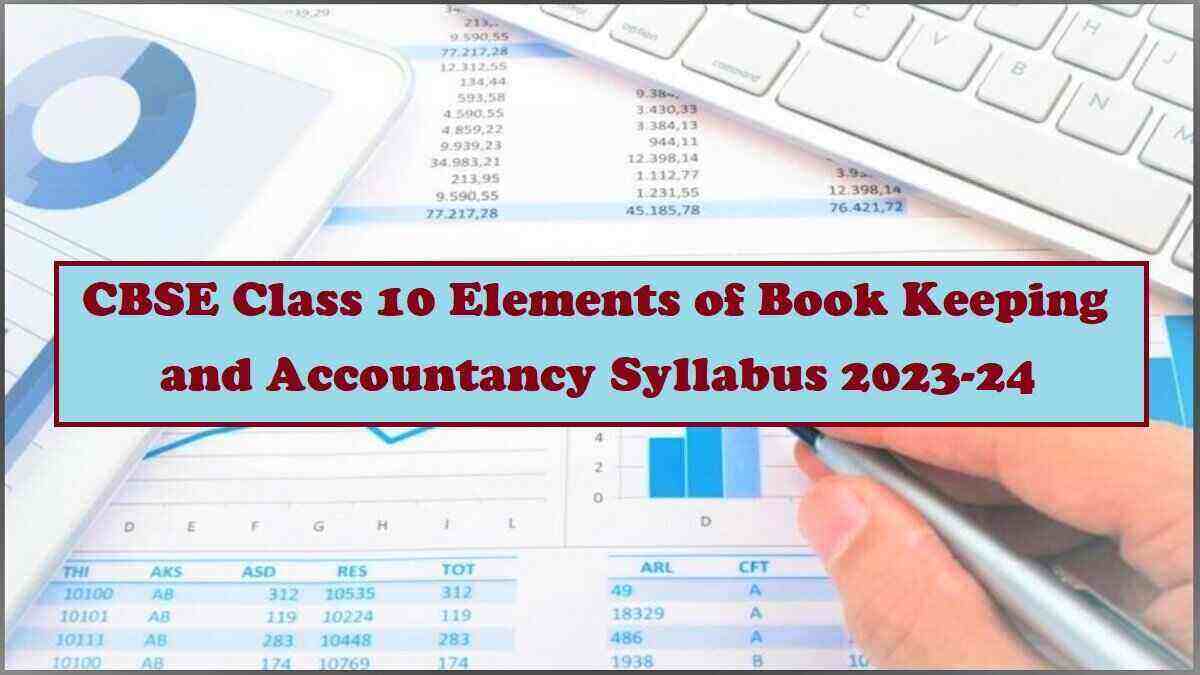CBSE Class 10 Elements of Book Keeping and Accountancy Syllabus 2023-24: Elements of Book Keeping and Accountancy has been included in the Class 10 Curriculum m by CBSE board to help students understand the fundamental principles involved in maintaining financial records. CBSE syllabus designed for Class 10 Elements of Book Keeping and Accountancy aims at developing skills of preparing and maintaining simple books of accounts from given details. Get here the full syllabus of CBSE Class 10 Elements of Book Keeping and Accountancy for the 2023-24 session.
CBSE Class 10 Elements Of Book-Keeping and Accountancy (Code No. 254) Course Structure 2023-24:
Total Marks – 100 (Theory + Project)
|
Theory Paper |
70 Marks |
|
Project Work |
30 Marks |
Time allowed for theory paper = 3 Hours
Unit-Wise Weightage Distribution
|
Unit |
Contents |
Marks |
Periods |
|
1 |
Capital and Revenue |
8 |
25 |
|
2 |
Depreciation |
12 |
35 |
|
3 |
Bank Reconciliation Statement |
14 |
45 |
|
4 |
Bills of Exchange |
10 |
25 |
|
5 |
Final Accounts |
14 |
45 |
|
6 |
Accounting from Incomplete Records |
12 |
35 |
|
|
Total |
70 |
210 |
|
|
Project |
30 |
30 |
CBSE Class 10 Elements Of Book-Keeping and Accountancy Course Contents 2023-24
Unit 1: Capital and Revenue
|
Content |
Learning Outcomes |
|
Capital and revenue : Capital and revenue receipts, capital and revenue expenditure and deferred revenue expenditure |
The learners would be able to : ● Recapitulate the meaning of the terms ‘Capital’ and ‘Revenue’ ● Appreciate the difference between capital and revenue receipts and capital and revenue expenditure ● Acquire the knowledge about deferred revenue Expenditure |
Unit 2: Depreciation
|
Content |
Learning Outcomes |
|
Depreciation : Need and methods of charging depreciation-straight line and Diminishing balance method (no change in the method) |
The learners would be able to : ● Explain the necessity of providing depreciation on fixed assets ● Develop the skill of using the different methods i.e. straight line and diminishing balance for computing depreciation ● Prepare fixed assets accounting using straight line and diminishing balance method of charging depreciation |
Unit 3: Bank Reconciliation Statement
|
Content |
Learning Outcomes |
|
Bank Reconciliation Statement : Meaning Preparation of BRS with the given cash book / pass book balance |
The learners would be able to : ● Understand the concept of bank reconciliation statement ● Appreciate the need of preparing bank reconciliation statement ● Develop understanding of preparing bank reconciliation Statement |
Unit 4: Bills of Exchange
|
Content |
Learning Outcomes |
|
Bill of Exchange : Nature and use of Bills of Exchange, Terms used in Bills of Exchange. Simple transactions related to bills of exchange (No dishonour, retiring & renewal of the bill) |
The learners would be able to : ● Acquire the knowledge of using bills of exchange for financing business transactions ● Understand the need of Bills of exchange in business ● State the meaning of different terms used in bills of exchange and their implication in accounting ● Develop in the skill of journalising simple bill transactions in the book of creditor and debtor |
Unit 5: Final Accounts
|
Content |
Learning Outcomes |
|
Final Accounts : Preparation of Trading and Profit & loss Account and Balance Sheet of Sole trader. Adjustment for closing stock only. [amount of closing stock to be given] |
The learners would be able to : ● State the meaning of financial statements & the purpose they serve for a sole proprietor. ● Develop the skill of preparing Trading Account and calculating gross profit. ● Develop the skill of preparing Profit & Loss Account and calculating the net profit ● Explain the need for preparing ‘Balance Sheet’. ● Understand the techniques of preparing the ‘Balance Sheet’. ● Develop the understanding to the simple adjustment for closing stock |
Unit 6: Accounting from Incomplete Records
|
Content |
Learning Outcomes |
|
Accounting from Incomplete Records : Meaning; preparation of statement of Profit, statement of affairs. [statement of affairs method only] |
The learners would be able to : ● State the meaning of incomplete records ● Understand the uses and limitations of incomplete records ● Develop the skill of computation of profit / loss by preparing Statement of Profit ● Develop the skill of preparing ‘Statement of Affairs’ and ascertain the position of the business on a particular date. |
Project Work
|
Project I (15 Marks) 15 Periods |
Project II (15 Marks) 15 Periods |
| Identify 20 items and classify them as capital and revenue receipts, capital and revenue expenditure and deferred revenue expenditure (OR any other topic related to the course content) | Make a statement of affairs for incomplete records of a small shop. (OR any other topic related to the course content) |
You can also download the above syllabus in PDF from the provided below:
Also Read:
CBSE Class 10 Sample Papers for Board Exam 2024 (All Subjects)
CBSE Class 10 Syllabus 2023-2024 (All Subjects)


